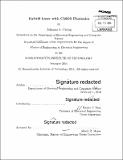| dc.contributor.advisor | Rajeev J. Ram. | en_US |
| dc.contributor.author | Chong, Johanna S | en_US |
| dc.contributor.other | Massachusetts Institute of Technology. Department of Electrical Engineering and Computer Science. | en_US |
| dc.date.accessioned | 2014-11-04T21:37:21Z | |
| dc.date.available | 2014-11-04T21:37:21Z | |
| dc.date.copyright | 2014 | en_US |
| dc.date.issued | 2014 | en_US |
| dc.identifier.uri | http://hdl.handle.net/1721.1/91446 | |
| dc.description | Thesis: M. Eng., Massachusetts Institute of Technology, Department of Electrical Engineering and Computer Science, 2014. | en_US |
| dc.description | 26 | en_US |
| dc.description | Title as it appears in MIT degrees awarded booklet, February 19, 2014: Multiwavelength integrated ring laser. Cataloged from PDF version of thesis. | en_US |
| dc.description | Includes bibliographical references (pages 151-153). | en_US |
| dc.description.abstract | In this thesis, an interesting approach for a photonic laser source is presented. By using integrated photonic resonators with an external gain medium, we are able to build a laser that offers a number of advantages including reducing the electrical and thermal load on the integrated chip socket, eliminating the challenges of integrating gain mediums into CMOS processes, allowing for lasing at virtually arbitrary wavelengths, the possibility of multiwavelength operation with a shared gain medium, elimination of closed-loop control of wavelength tuning, ability to control laser output and wavelength on-chip, and the potential for wavelength modulation using novel resonator tuning designs. Several iterations of the laser were built and characterized culminating in a final integrated laser that showed a wall-plug efficiency of 1.10% at a maximum output power of 6 mW. We demonstrate even higher wall-plug efficiencies using commercial filters. We also demonstrate wavelength modulation and open eye diagrams for data rates up to 5 Gb/s using the laser in a communications link. Simulations of birefringent filters are performed to model wavelength dependence on polarization which when manipulated can give rise to single or multiwavelength lasing. Finally, the power spectral density is simulated by assuming uncorrelated phase between lasing modes. | en_US |
| dc.description.statementofresponsibility | by Johanna S. Chong. | en_US |
| dc.format.extent | 153 pages | en_US |
| dc.language.iso | eng | en_US |
| dc.publisher | Massachusetts Institute of Technology | en_US |
| dc.rights | M.I.T. theses are protected by copyright. They may be viewed from this source for any purpose, but reproduction or distribution in any format is prohibited without written permission. See provided URL for inquiries about permission. | en_US |
| dc.rights.uri | http://dspace.mit.edu/handle/1721.1/7582 | en_US |
| dc.subject | Electrical Engineering and Computer Science. | en_US |
| dc.title | Hybrid laser with CMOS photonics | en_US |
| dc.title.alternative | Multiwavelength integrated ring laser | en_US |
| dc.type | Thesis | en_US |
| dc.description.degree | M. Eng. | en_US |
| dc.contributor.department | Massachusetts Institute of Technology. Department of Electrical Engineering and Computer Science | |
| dc.identifier.oclc | 893681172 | en_US |
